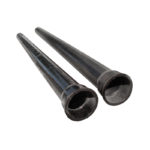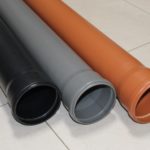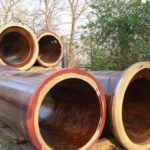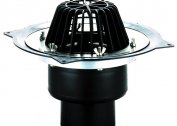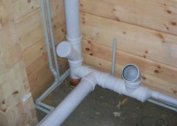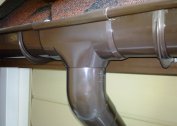Sewage is called an engineering structure, through which the contaminated used water, fecal matter, excess rainfall, groundwater from the facility are discharged. Thanks to this system, it is possible to maintain optimal sanitary conditions for living or production according to SanPin. Drainage communication allows you to remove the effluent into a common receiver for the purpose of their further treatment before discharge into the nearest body of water or reuse for technical needs.
Types and device
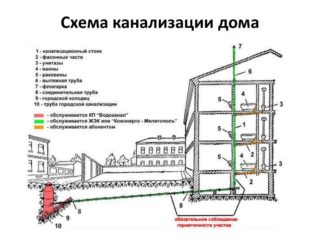 There are several varieties of wastewater systems:
There are several varieties of wastewater systems:
- Storm sewage. It contributes to the surface removal of excess moisture from the foundation of the house and from its pitched roof with a large amount of rainfall in the region. The stormwater drainage system includes a roof drainage system and linear channels for further transporting water to the nearest ravine, ditch, pond, septic tank or central sewer.
- Drainage. Closed communication removes excess groundwater from the site. It looks like interconnected pipes laid underground at a depth of 1.5 m. The liquid is discharged into water bodies or wells. No cleaning required.
- Household. A facility through which all used water is removed from the apartment / house to the central sewer. The difference with previous systems is that faecal matter, sewage from washing, washing dishes, etc. are removed through pipes.
Drainage is divided into internal and external. The first option is the entire part located in the building. The second is everything that is beyond. In turn, the outer part of the drainage system can be general-alloy (both rain and domestic water are disposed of), semi-separate (sewage flows through different pipes, but merge into one receiver), separate (contaminated domestic water, industrial and storm waste move in different ways). channels to separate VOCs).
Unorganized removal of rain / melt water from the site leads to waterlogging.
Materials of manufacture
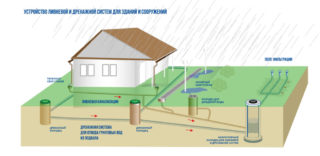 When installing drainage systems, it is important to choose the right material for the construction device. Typically, polymer trays or galvanized steel gutters are preferred for the roofing system. They are lightweight, inert to corrosion and cost acceptable. However, the metal is too "noisy" during the rain. This is worth considering.
When installing drainage systems, it is important to choose the right material for the construction device. Typically, polymer trays or galvanized steel gutters are preferred for the roofing system. They are lightweight, inert to corrosion and cost acceptable. However, the metal is too "noisy" during the rain. This is worth considering.
For laying an open linear storm shower in private construction, it is better to purchase trays of composite, polymers or asbestos cement. They are easy to transport and stack, are not afraid of temperature changes, do not respond to aggressive impurities in the drains. It is only important that the gutters are selected in accordance with the required throughput and have protective grilles.
For the sewage system, you can choose pipes from the following materials:
- Cast iron. The metal is durable (lasts up to 70 years), durable, not afraid of temperature changes. Due to the insufficiently smooth inner wall, silt deposits quickly form inside. The weight and price of cast iron pipes are quite high.
- Plastic. For the inside of the communication, PVC or polypropylene is preferred. The external network is better to install from HDPE pipes. Low-pressure polyethylene is plastic, inert to temperature extremes, and has a perfectly smooth surface. PVC pipes have the same characteristics, but brown. They are designed for the outer part of the drainage system. Inside the building, gray tubes are used.
- Ceramics. Such pipes are used outside. Ceramic collector withstands temperature extremes, has a smooth wall surface, is inert to chemical inclusions. Such material is impressive. Working with him is not easy due to the large mass.
- Cast iron
- Plastic
- Ceramics
For large public collectors, reinforced concrete pipes are used.
Installation Steps
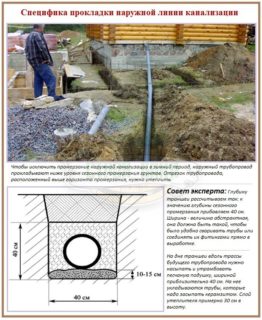 Different types of effluent removal systems are mounted as follows:
Different types of effluent removal systems are mounted as follows:
- Roofing The trays are mounted around the entire perimeter of the roof with a slope towards the sewer.
- Linear rainfall. Prepare trenches, the bottom of which is compacted. Then a layer of sand is poured and compacted. 5-7 cm thick concrete mixture is poured on top of the sand cushion. After it dries, the trays are laid. On the sides they are also filled with a solution. Protective grilles are laid on top.
- Drainage drainage. Under the drains, canals are prepared below the groundwater level. Sand is poured at the bottom of the trenches, and then a fine fraction of crushed stone. Perforated pipes in geotextiles are laid on it. From above again they sprinkle with rubble and bury the canals.
- A domestic drainage system is mounted in series. First, its inner part, then the outer one. The minimum diameter of the pipes for drainage in the apartment is 50 mm. From the toilet - 110 mm. The central riser has a cross section of 110-150 mm. The pipes of the outer part are taken with a section of 160-220 mm. All drainage elements are interconnected using fittings, adapters, tees.
Any of the systems should have a bias towards the common house riser or private septic tank. The calculation is done depending on the cross section of the pipes. The larger it is, the smaller the bias can be.
Sewage in utility bills
In the receipts for utilities utilities there is a column "water disposal". It involves the removal of all consumed water to the urban VOC through the sewer pipe system from the apartment / house. The tariff includes not only the transportation of effluents, but also their subsequent treatment, and then the proper disposal. Users of hot and cold water pay for the entire process to which the effluents from the apartment / house at the local treatment plant are exposed, including its content. The exception is private homeowners in suburban settlements that are not connected to the central city highway and dump their effluents into a personal septic tank. They pay only for the supply of water.
How to calculate the cost of the service
 If there is a need to calculate the cost of wastewater services, they do this by summing up the consumed cubes of water and then multiplying the value by the tariff for the service. The formula will look like this:
If there is a need to calculate the cost of wastewater services, they do this by summing up the consumed cubes of water and then multiplying the value by the tariff for the service. The formula will look like this:
- Amount of payment for water disposal = (HVS m3 + GVS m3) x Tariff
For example, the counters show that the user has consumed 3 m3 of cold water and 5 m3 of hot water. As a result, we have 8 m3. We multiply by a single tariff 16 rubles. and get 128 rubles for payment.
If the counters show that the total water consumption per month was 8 m3, and 10 m3 is indicated in the water discharge column, this is a gross violation. Physically, the user cannot dispose of more waste water than the number of cubic meters of water consumed. In this case, it is worth filing a complaint with the management company, and if necessary, with the court.
If there are no water meters in the apartment, the amount for the drainage service is calculated based on the norms of water consumption per person established for a specific period. By law, they are different for each region and published in local media.
In apartment buildings, the calculation of the water disposal service is calculated by the common house meter and is divided into all apartments. In this case, the payments are marked DPU (home metering devices) or ONE (common house needs).
Some users want to install a personal meter in the apartment not only for water supply, but also for water disposal. To do this, you need to submit an application for the installation of the device and its sealing. In the future, you can calculate the water disposal service, regardless of the common house meter with a marking in the receipt of the KPU (apartment metering devices).
